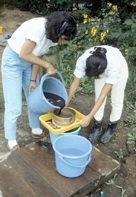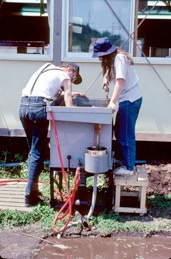East Asia

Excavations, flotation, palaeoethnobotany etc.
My involvement in East Asian archaeology began when I was invited by my undergraduate advisor, Prof. William Hurley, to join him on a project in Hokkaido, Japan, in 1974. His invitation in turn was extended by Prof. Masakazu Yoshizaki of Hokkaido University in Sapporo. I am aware of only two efforts to conduct flotation in Japan before then, one effort by Yoshinobu Kotani, a PhD student at the University of Wisconsin in the early 1970s and another by Michiko Mori-Chiura who had studied at the University of Toronto as an undergrad. When she went to work at International Christian University in Tokyo she introduced flotation to local archaeological projects. Kotani’s and Mori-Chiura’s work made it clear that systematic collection of plant remains from Japanese sites would be as revolutionary as it was becoming in many other places in the world. Flotation was (surprisingly) still not all that common but many major projects such as the one at Salts and Mammoth Caves, Kentucky and many others in SW Asia incorporated flotation.
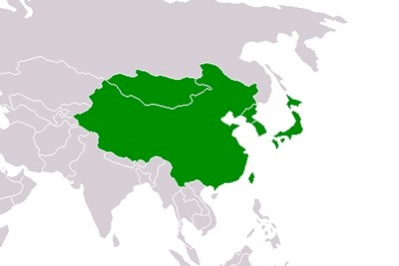
1974
-
Salvage work was underway at the Early Jomon Hamanasuno site so when we joined the project in 1974, archaeologists had completed a survey of Minamikayabe as well as two excavation seasons at Hamanasuno. We began a program of systematic soil sampling and flotation at the site, the results of which became my MA thesis. It was tough going, using the bucket decanting method (video) I had learned on a project in Wisconsin in 1972. Nevertheless we got results which have informed my research to this day (see my 2008 World Archaeology paper), While I worked on these materials and began the next phase of my research I was studying with people such as Richard Yarnell, Stephen Polgar, Patty Jo Watson and William Marquardt. I joined the Shellmounds Archaeological Project (SMAP) in the Big Bend region of Kentucky and cut my teeth on early agriculture/hunter-gatherer research by working on samples from two shellmounds belonging to the Indian Knoll culture. I applied what I learned in the SMAP project to my work in Japan.
Bucket decanting flotation.
For a video, click here.
-
A more extensive chronological and regional coverage of Jomon occupations related to Hamanasuno was our next step. I returned to Hokkaido to begin my PhD research and I was able to plug into a series of excavations at Hamanasuno, Usujiri B (Middle Jomon), Hakodate Airport (Initial Jomon), and Seizan (Late Jomon). I experimented with several flotation methods but the arrival of a forth flotation machine, acquired by William Hurley, was the method of choice at the time. I conducted a comparison of the results of three slightly different methods and the main advantage of the froth machine was the larger volume of soil we could process in a day. Some days we processed up to 300 litres of sediment.
-
Flotation was still not being used much in Japan other than at ICU and in Minamikayabe. Archaeological budgets were not set for it and archaeology in Japan was going through a debate about the virtues of scientific archaeology in the context of a primarily historical discipline. The key was my development of a lifelong friendship and intellectual collaboration I developed with Masakazu Yoshizaki
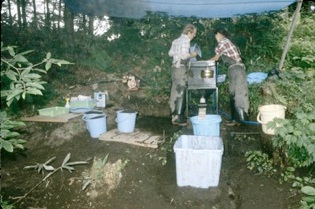
From 1979-1981 William Hurley, Peter Bleed, Yoshizaki and I as well as others undertook a collaborative project that focused on the Early Yagi site in Minamikayabe. Here we mainly used the froth flotation machine but we were also able to ask a number of questions related to resource procurement and settlement through a form of catchment analysis conducted by Anne Bleed. By the early 1980s we had a much better perspective on the Jomon. I was able to incorporate this conceptualization when I published my monograph on the Kameda Peninsula Jomon in 1983.
1983
Hokkaido University had begun to grow and university officials understood that the extensive archaeological resources on campus needed rescuing. Much of the occupation on campus was Satsumon (roughly A.D. 700-1100), that is, the direct ancestors of the AInu. Not long after the campus excavations began and a salvage archaeology centre was established, more and more archaeology was being done in Sapporo and the surrounding region. The discovery of large quantities of cultigens at the Sakushu Kotoni River site on the university campus convinced everyone that flotation had to be part of every archaeological project in Hokkaido. Project Seeds began, I received a fellowship to conduct research at Hokkaido University in 1986 and with the help of the Dean, Prof. Yoshizaki was able to install a Scanning Electron Microscope in the lab. Yasuyo Tsubakisaka who had been helping us for many years had become a full-time lab manager and coordinator of both on-site flotation and lab analysis after working with my then students, Hiroto Takamiya and Cathy D’Andrea.
1987
Through the 1980s my research was supported by SSHRC with a year of funding by the Japan Society for the Promotion of Science. In the late 1980s we broadened our scope and added a volunteer supported program through Earthwatch. Our large flotation tank was turning out to be unwieldy so local crews (mainly women) suggested changing the proportions of the tank so that it was smaller and rectangular. A Japanese team made one of these new tanks with a transparent box so that we could demonstrate what was going on in the tank. This is the flotation device we’ve used ever since. It is now widely used in Korea and China as well as in Japan.
While lecturing in South Korea I met Gyoung-Ah Lee (now a Professor at the University of Oregon) who was studying agricultural origins at Seoul National University. Ultimately her PhD dissertation on the subject written at the University of Toronto is the latest word on the subject. The methods she used were modified from our methods developed in Japan and Ontario over the years. Methods we all use are truly hybrid, improved upon and adapted to the circumstances of each region where they are applied.
South Korea 1993
1986 Heilongjiang, China
The discovery of an agricultural complex in Hokkaido that began around the 8th century A.D. and involved nearly all common East Asian cultigens as well as some from Southwest Asia meant that we needed to get a better handle on its connections inside and outside Japan. My Japanese colleagues had been collaborating with scholars from NE China so access to the area was straightforward. I headed to China, invited by archaeologists in Harbin, to learn what I could and to explore potential research there. One auspicious event was an invitation to collect a flotation sample from a house at the Baijinbao site. We floated the small sample using the bucket decanting method and recovered a couple of grains of millet. As far as I know this may be the first time flotation was conducted on a Chinese sample.
1976
At the time, my research and teaching capabilities somehow demonstrated that I might have some value in administration so from 1992 to the present I have been a Chair, an Associate Dean, and once again a Chair among other administrative jobs. I decided to work closer to home and developed an archaeological program near my university in collaboration with David G. Smith. In the mid-1990s Chen Shen, Bishop White curator at the Royal Ontario Museum and Fang Hui of Shandong University contributed to the project. Anne Underhill of the Field Museum in Chicago visited us and learned how we do flotation. She immediately (1999) began flotation at Liangchengzhen in Shandong Province. She used one of the new hybrid flotation machines built in Mississauga.
China 1994-2003
China 2003 - present
My role in recent years has been one of teacher, researcher and devil’s advocate. A multi-year research grant from SSHRC (Social Sciences and Humanities Research Council of Canada) to analyze and interpret plant remains in collaboration with the late K.C. Chang and his successors, Robert Murowchick and David Cohen; Jian Leng, Li Liu, and Anne Underhill has permitted otherwise unattainable insights on Early Neolithic North China. I have co-supervised a doctoral dissertation at Shandong University by Xuexiang Chen who studied at the University of Toronto for a year. Currently, another student. Yan Pan from Fudan University in Shanghai, is working on her dissertation research on early agriculture in Zhejiang Province. She will be at the University of Toronto from 2007-2009.
As part of our comparative research and expansion of our perspective on Japan, A.C. (Cathy) D’Andrea conducted her PhD research in eastern Aomori (Middle and Late Jomon as well as Tohoku Yayoi) and on the east coast of Hokkaido (Zoku-Jomon). Her work has been published in a series of papers.
Tohoku, Japan late 1980s-1992
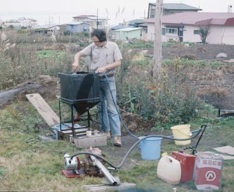
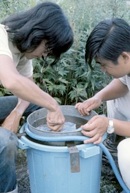
Above: Froth flotation at the Hamanasuno SIte, 1977.
Inset: charred material caught in froth ready to overflow into sieves.
Above: Garbage can flotation experiment, 1977
1979-1981
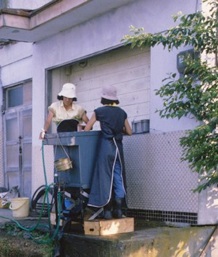
The flotation machine we were using was a transformation of the oil-drum based device that the SMAP project used. I needed something that packed easily into or onto a car, was collapsable, light and could be emptied without having to tip it over. The froth flotation machine had many of these attributes but was turning out to be environmentally unfriendly in urban settings (the pump was noisy, the exhaust smelled and we had to add kerosene and another chemical to the water). So with the help of the machine shop at the University of Toronto Mississauga, we came up with a hybrid SMAP/froth flotation machine (video) with a light metal frame and a a PVC tank (compare with middle photo below). We added a shelf for the sieves instead of hanging them from the tank. It was large so that we could process the large Jomon samples we needed but the size limited its usefulness in the end. We also used it in Ontario but the logistics were simpler there.
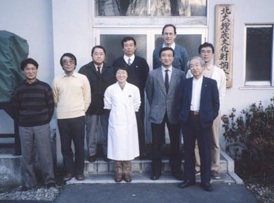
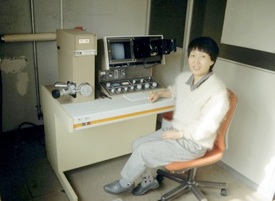
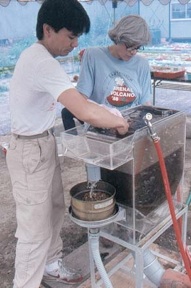
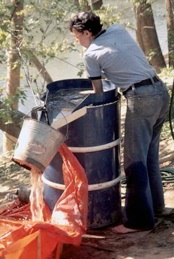
Original SMAP Machine and Patty Jo Watson 1975
Our first hybrid SMAP Machine 1986-1991. For a video, click here.
Hokkaido University Team. Yoshizaki is 3rd from left. I’m not difficult to miss.
Ms. Tsubakisaka and SEM at Hokkaido University
Hiroto Takamiya and Earthwatch volunteer using our current design of the hybrid SMAP machine in Hokkaido ca. 1990. Note the transparent tank. Takamiya is now a Full Professor at Sapporo University and has been conducting archaeobotanical research in Okinawa for many years.
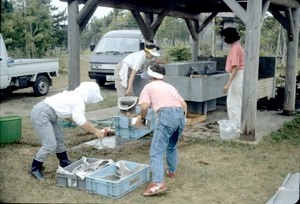
Cathy D’Andrea and flotation team at Hachinohe, Aomori Prefecture
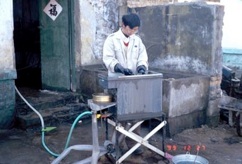
I kept returning to China during the late 1980s and 1990s, learning as much as I could about the country’s archaeology. I began to teach a course on East Asia that incorporated the growing new body of data from a rapidly emerging modernized archaeology. Two key events are memorable. K.C. Chang began a major research project in Henan in 1994 and a good friend and colleague, Jian Leng, was one of his key staff members. She visited my home in Mississauga where I taught her bucket decanting flotation in my kitchen. Soon thereafter she was teaching a small crew all about flotation and by 1994 bucket decanting was in use at the Mazhuang site, then at Panmiao, Shantasi and other localities.
Another auspicious moment was meeting Jimmy Zhao in Nanchang, China in 1997. Scotty MacNeish and I had been investigating early agriculture in Jiangxi Province, China over the years and we all met at a conference in Nanchang and toured Diaotunghuan and XIenrendong. Bryan Gordon, a friend of Scotty’s from the National Museum of Civilization in Canada was there too. He got the rice “bug” and established an important web site that serves to inform on agriculture in China. Jimmy had just finished his dissertation based on rice phytoliths and had moved back to China and was expanding his research base. In 1998 he came to my lab and he studied with me for a time, learning the fundamentals of macroremains analysis. Since then we have been collaborating on a number of projects and he has become the first native professional archaeobotanist in China. He has been instrumental in putting my Japanese version of the SMAP machine to use throughout China.
Flotation at Liangchengzhen using the hybrid SMAP flotation device, 1999. Photo by Anne Underhill
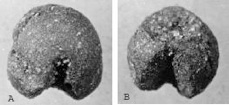
Broomcorn millet (ventral and dorsal views) from the Baijinbao site recovered in 1986 by bucket decanting flotation.
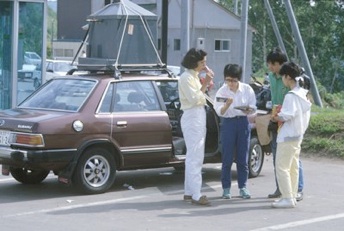
Although the new hybrid flotation device was large, we could still transport it by car.
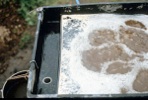
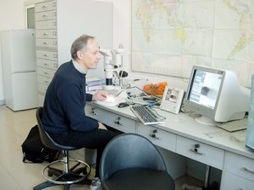
Here I am at “work” in the archaeobotany lab at Shandong University. Given the increasing importance of archaeobotany to China, Shandong U. decided such a lab was a high priority. With the assistance of Professors Fang and Luan and Xuexiang Chen, then a student, we set up the facility when I was there as a Liqing Fellow.
